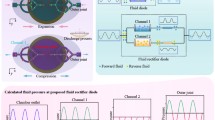Abstract
With the characteristic of small size, lightweight, low energy dissipation, the laminated piezoelectric is suitable for micro-electromechanical system, which still needs an external amplification mechanism because of its low output displacement. As for the application of the micro-channel cooling system in the micro-pump, the leveraged mechanism, the bridge mechanism and the hydraulic mechanism have been proceed numerical modeling, dynamic simulation and optimizing in this paper. In this study, the amplifier is designed within the volume of 15 mm × 15 mm × 5 mm. The volume of the leveraged mechanism, the bridge mechanism and the hydraulic mechanism are 345 mm3, 1125 mm3 and 240.21 mm3 respectively. Moreover, the best magnification and frequency for the above three magnifying mechanisms are 134.8 and 69.4 Hz, 61.52 and 5.26 kHz, 50.6 and 6.94 kHz respectively. The performance of a micro-pump is a combination of the output quantity per time and the output frequency. Compared to other two magnifying mechanisms, the hydraulic mechanism is smaller, more stable and faster in response. Taking into consideration all these above factors, the hydraulic mechanism is more suitable for the micro-pump used in a micro-channel cooling system. The hydraulic micro-displacement amplifying mechanism also can be used in developing tools for other fields such as medicine, chemistry and so on.
Zusammenfassung
Aufgrund seines kleinen Volumens, niedrigen Gewichts und die Besonderheit von wenigen Energieverbrauch hat der Piezostapel an Bedeutung für das mikroelektromechanische System gewonnen. Allerdings wird ein externes Verstärkungssystem wegen der geringen Ausgangsverschiebung benötigt. In diesem Artikel wird der Fokus auf der Anwendung des Mikrokanal-Kühlungssystems in der Mikropumpe gelegt. Hierbei werden drei weitverbreitete Micro-Verstärkungssysteme, nämlich der Hebelmechanismus, der Brückenmechanismus und der Hydraulikmechanismus numerisch modelliert, dynamisch simuliert und optimiert. In dieser Studie ist der Verstärker mit einem Volumen von 15 mm × 15 mm × 5 mm ausgelegt. Das Volumen von Hebelmechanismus, Brückenmechanismus und Hydraulikmechanismus beträgt jeweils 345 mm3, 1125 mm3 und 240,21 mm3. Die beste Vergrößerung und Frequenz von obengenannter drei Mechanismen sind jeweils 134,8 und 69,4 Hz, 61,52 und 5,26 kHz, 50,6 und 6,94 kHz. Die Leistung einer Mikropumpe ist abhängig von der einmaligen Ausgangsmenge und der Ausgangsfrequenz. Zusammenfassend ist der Hydraulikmechanismus mit kleinerem Volumen, bessere Sensibilität und gute Stabilität gegenüber den zwei anderen Mechanismen optimaler. Darüber hinaus wird er in den Bereichen wie Medizin und Chemie eingesetzt.
















Similar content being viewed by others
References
Lin L, Chen YY, Zhang XX et al (2014) Optimization of geometry and flow rate distribution for double-layer microchannel heat sink. Int J Therm Sci 78:158–168. https://doi.org/10.1016/j.ijthermalsci.2013.12.009
Kleiner MB, Kuhn SA, Haberger K (1995) High performance forced air cooling scheme employing microchannel heat exchangers. IEEE Trans Compon Packag Manuf Technol Part A 18(4):795–804. https://doi.org/10.1109/95.477466
Li QL, Chen LX (2008) Delivery and control techniques for micro-fluids. Prog Chem 20(9):1406–1415
Huang J, Zhang J, Shi W et al (2016) 3D FEM analyses on flow field characteristics of the valveless piezoelectric pump. Chin J Mech Eng 29(4):825–831. https://doi.org/10.3901/CJME.2016.0427.061
Galas JC, Studer V, Chen Y (2005) Characterization of pneumatically activated microvalves by measuring electrical conductance. Microelectron Eng 79(2):112–117. https://doi.org/10.1016/j.mee.2004.12.016
Maronn M, Chamlin S, Metry D (2005) A MEMS microvalve with PDMS diaphragm and two-chamber configuration of thermo-pneumatic actuator for integrated blood test system on silicon. Sens Actuators A 119(2):468–475. https://doi.org/10.1016/j.sna.2004.10.023
Yang Y, Liu J (2009) Flexibly driving micro flow in a Lab-on-Chip system via dry porous structure. Forsch Ingenieurwes 73(4):219–229. https://doi.org/10.1007/s10010-009-0107-2
Luharuka R, Leblanc S, Bintoro JS et al (2008) Simulated and experimental dynamic response characterization of an electromagnetic microvalve. Sens Actuators A 143(2):399–408. https://doi.org/10.1016/j.sna.2007.10.084
Ashouri M, Behshad Shafii M, Moosavi A (2017) Theoretical and experimental studies of a magnetically actuated valveless micropump. J Micromech Microeng 27(1):15016. https://doi.org/10.1088/0960-1317/27/1/015016
Hamid NA, Majlis BY, Yunas J et al (2016) A stack bonded thermo-pneumatic micro-pump utilizing polyimide based actuator membrane for biomedical applications. Microsyst Technol. https://doi.org/10.1007/s00542-016-2951-y
Yoshida T, Tachiki A, Ishii N et al (2014) 4He crystals on an oscillating plate. J Low Temp Phys 175(1/2):120–125. https://doi.org/10.1007/s10909-013-0929-z
Oh CH, Choi JH, Nam HJ et al (2010) Ultra-compact, zero-power magnetic latching piezoelectric inchworm motor with integrated position sensor. Sens Actuators A 158(2):306–312. https://doi.org/10.1016/j.sna.2010.01.022
Ling MX, Liu Q (2016) Analytical model and finite element analysis of piezoelectric displacement amplification mechanism. Opt Precis Eng 24(4):812–818. https://doi.org/10.3788/OPE.20162404.0812
Bae GH, Hong SW, Lee DW (2014) A study on precision stage with displacement magnification mechanism using flexure-based levers. Res J Appl Sci Eng Technol 7(11):2225–2231. https://doi.org/10.19026/rjaset.7.520
Lobontiu N, Garcia E (2003) Analytical model of displacement amplification and stiffness optimization for a class of flexure-based compliant mechanisms. Comput Struct 81(32):2797–2810. https://doi.org/10.1016/j.compstruc.2003.07.003
Ninomiya T, Okayama Y, Matsumoto Y et al (2011) MEMS-based hydraulic displacement amplification mechanism with completely encapsulated liquid. Sens Actuators A 166(2):277–282. https://doi.org/10.1016/j.sna.2009.07.002
Zhang JL, Chen WY et al (2009) Design and simulation of a kind of micro-displacement amplification mechanism. J Mach Des 26(12):9–12
Chen G, Shao X, Huang X (2008) A new generalized model for elliptical arc flexure hinges. Rev Sci Instrum 79(9):95103. https://doi.org/10.1063/1.2976756
Wang H, Yu W, Chen G (2017) An approach of topology optimization of multi-rigid-body mechanism. Comput Aided Des 84:39–55. https://doi.org/10.1016/j.cad.2016.12.002
Schomburg WK (2011) Introduction to microsystem design. Springer, Berlin
Author information
Authors and Affiliations
Corresponding author
Rights and permissions
About this article
Cite this article
Zhang, Y., Li, D., Chen, Y. et al. Design of micro-displacement amplifier for the micro-channel cooling system in the micro-pump. Forsch Ingenieurwes 84, 161–168 (2020). https://doi.org/10.1007/s10010-020-00394-2
Received:
Accepted:
Published:
Issue Date:
DOI: https://doi.org/10.1007/s10010-020-00394-2



